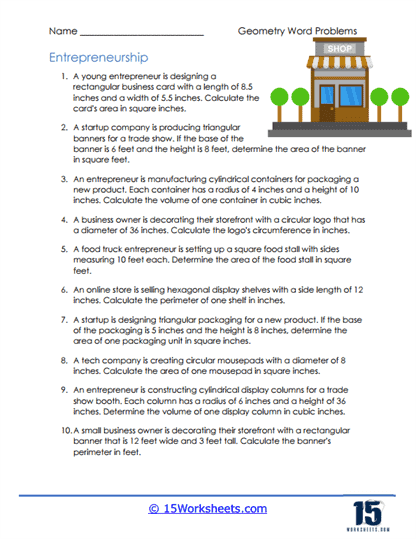Entrepreneurship

Worksheet Description
This worksheet is centered around the theme of entrepreneurship and involves a series of geometry word problems that relate to business activities. It includes problems that require calculating the area of a business card, the area of banners for trade shows, the volume of cylindrical containers for products, and the circumference of a logo. Students are challenged to apply geometric concepts to entrepreneurial scenarios, such as setting up a food stall, designing shelf space, creating packaging for products, and decorating a storefront.
The worksheet is designed to teach students how to apply geometry in practical business-related contexts. It focuses on calculating area, volume, and perimeter using different shapes such as rectangles, cylinders, and hexagons, which are relevant to product design, marketing, and store layout. By solving these problems, students reinforce their understanding of geometric calculations while gaining insight into how these skills are useful in entrepreneurship. The worksheet also aims to enhance problem-solving abilities and encourage the application of math in the innovative field of business creation.
Example Problems
1. A young entrepreneur is designing a rectangular business card with a length of 8.5 inches and a width of 5.5 inches. Calculate the card’s area in square inches.
2. A startup company is producing triangular banners for a trade show. If the base of the banner is 6 feet and the height is 8 feet, determine the area of the banner in square feet.
3. An entrepreneur is manufacturing cylindrical containers for packaging a new product. Each container has a radius of 4 inches and a height of 10 inches. Calculate the volume of one container in cubic inches.
4. A business owner is decorating their storefront with a circular logo that has a diameter of 36 inches. Calculate the logo’s circumference in inches.
5. A food truck entrepreneur is setting up a square food stall with sides measuring 10 feet each. Determine the area of the food stall in square feet.
6. An online store is selling hexagonal display shelves with a side length of 12 inches. Calculate the perimeter of one shelf in inches.
7. A startup is designing triangular packaging for a new product. If the base of the packaging is 5 inches and the height is 8 inches, determine the area of one packaging unit in square inches.
